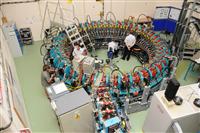EMMA milestone beams its way to a world first
A brand new technology that promises a range of applications from treating cancer to powering safer nuclear reactors has reached another world first in its development. This milestone was confirmed
 |
|
EMMA Accelerator at STFC's Daresbury Laboratory (picture from STFC website) |
EMMA is a proof of principle prototype for a brand new type of particle accelerator, designed by an international team of scientists, including a number of the UK's top universities and institutes. A major part of the BASROC CONFORM project, EMMA is funded by the Research Councils UK (RCUK) Basic Technology programme. A supporting statement and quotes from the CONFORM project and its members is available at https://www.conform.ac.uk/news/EMMAacceleration.pdf.
Particle accelerators already have a wide range of uses in many areas of science, but their potential is limited by their size, complexity and cost. EMMA will provide the technology to overcome these issues and take these applications to a new level. A compact 20 million electron volt prototype, EMMA not only uses technology that is simpler and less expensive than equivalent accelerators in existence, it also promises applications from treating cancer to powering safer nuclear reactors that produce less hazardous waste.
EMMA has now achieved its most significant milestone yet. For the first time, an electron beam was steered around the circumference of EMMA's ring and then successfully accelerated to 18 MeV. This momentous milestone, and a world first, not only confirms that the design of the most technically demanding aspects of EMMA is sound, it also demonstrates the feasibility of EMMA's technology, which now paves the way for the construction of a whole new generation of more powerful, yet more compact and economical accelerators.
EMMA's concept is based on a ring of magnets which use their combined magnetic field simultaneously to steer and focus the electron beam around the machine. The strength of the magnetic field increases as the beam spirals outwards while it is accelerated around the ring. Due to the strength of the magnetic focussing, the displacement of the beam as it accelerates and spirals around the ring is much smaller than in any equivalent accelerator. As a result, EMMA's ring of magnets is much more compact and the beam is better controlled. EMMA's next steps will be to move towards full acceleration from 10 to 20 MeV and commence the detailed characterisation of the EMMA accelerator and its novel acceleration scheme.
EMMA is the result of a truly multidisciplinary team from several world leading establishments which make up the CONFORM project. These include the Universities of Manchester, Oxford, Surrey, Imperial, Brunel and Huddersfield, the Cockcroft and John Adams Institutes, STFC and a number of international partners and UK industry. It was then design engineered and constructed by STFC's scientists at its Daresbury Laboratory.
Source: STFC Website